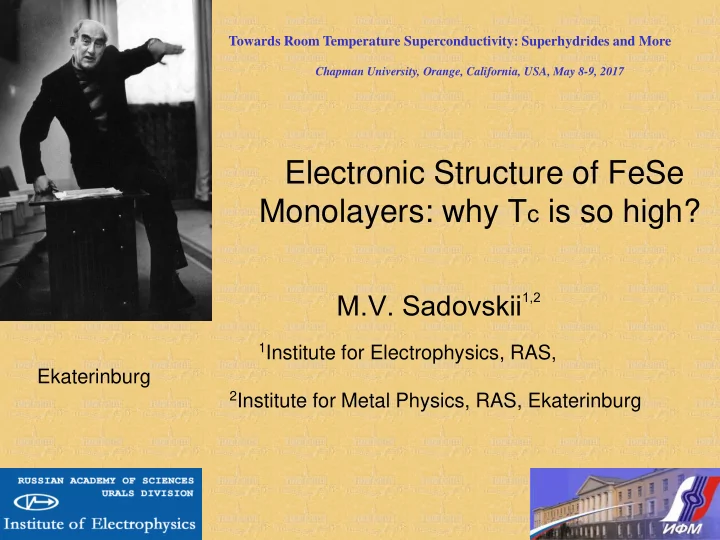

Towards Room Temperature Superconductivity: Superhydrides and More Chapman University, Orange, California, USA, May 8-9, 2017 Electronic Structure of FeSe Monolayers: why Т с is so high? M.V. Sadovskii 1,2 1 Institute for Electrophysics, RAS, Ekaterinburg 2 Institute for Metal Physics, RAS, Ekaterinburg
Outline of the talk: FeSe monolayers - experiment FeSe monolayers – electronic structure (a) Role of correlations (b) The origin of shallow and “replica” bands T c enhancement puzzles: (a) Doping in multiple band system (b) “Excitonic” mechanism (c) Forward scattering Higher T c ?
Essentially physics of FeAs layers! LiFeAs Li +1 Fe +2 As -3 LaOFeAs BaFe 2 As 2 FeAs tetrahedra form two-dimensional layers surrounded by LaO, Ba or Li. Fe ions inside tetrahedra form a square lattice.
LDA band structure of tetragonal LaOFeAs Essentially multiband problem Fe-3 d As- 4 p O-2 p I.A. Nekrasov et al., JETP Lett. 87 , 560 (2008)
FeAs systems: LaOFeAs LiFeAs BaFe 2 As 2 Pnictogen height? LiFeAs
LDA+DMFT: strong or intermediate correlations?
Superconducting gap – ARPES data Superconducting gap – ARPES data arXiv: 0807.0419 Schematic picture of superconducting gaps in Ba 0.6 K 0.4 Fe 2 As 2 . Lower picture represents Fermi surfaces (ARPES intensity), upper insert – temperature dependence of gaps at different sheets of the Fermi surface.
ArXiv: 0807.2369, 0807.4315, 0807.4775 ArXiv:0807.4312
+1 Fe +2 2 Se -2 K x 2 ?
ArXiv: 1102.1057 No nesting!
K x Fe 2-y Se 2 : LDA+DMFT Spectrum I.A.Nekrasov, N.S.Pavlov M.V.Sadovskii, ArXiv:1211.3499 U=3.75 eV J=0.56eV =40 Correlations important! LDA bands narrowing ~5 Strong damping near FS LDA+DMFT LDA’+DMFT CT-QMC LDA+DMFT LDA’+DMFT ARPES dispersions: Z.X.Shen et al. ArXiv:1208.5192
Detailed LDA + DMFT in KFeSe system M. Sunagawa et al. Journal of the Physical Society of Japan CT-QMC 85, 073704 (2016)
ArXiv:1201.5694 ArXiv:1402.1357
ArXiv:1406.3435
ArXiv:1202.5849
I.A. Nekrasov (unpublished) LiOHFeSe FeSe1UC ArXiv:1505.06361
ArXiv:1207.6823
ArXiv:1402.1357
LDA in single layer FeSe I.A. Nekrasov, Wien 2k N.S. Pavlov (unpublished) E F I.A. Nekrasov (unpublished) undoped E F Self – doping at the interface? E F shift ~ +0.25 eV (or 0.2 electron per Fe) e-doped
LDA + DMFT in single layer FeSe ARPES: ArXiv:1312.2633 CT-QMC: =40, U=3.5eV, J=0.85eV I.A.Nekrasov, N.S.Pavlov (2016)
ArXiv:1606.09358
LDA + DMFT in single FeSe/STO layer CT-QMC: =40, U=5eV, J=0.90eV
LDA + DMFT in single FeSe/STO layer Probably phonons are irrelevant for the formation of the “replica” band?
LDA + DMFT in single FeSe/STO layer
Tc and Density of States Correlation arXiv:1001.1801
BCS – multiple band model Multiple bands: 1/ g eff Matrix of dimensionless coupling constants V. Barzykin, L.P. Gorkov. Pis'ma ZhETF 88, 142 (2008) Secular equation, physical solution corresponds to a maximal positive value of geff , which determines the highest value of Tc
Effective coupling – from weak to strong? Effective coupling ! Effective coupling constant g eff is significantly larger than the pairing constant g on the small hole - like cylinder . It can be said that coupling constants from different cylinders effectively produce “ additive ” effect. In fact this can lead to high enough values of T c even for relatively small values of intraband and interband pairing constants. E.Z.Kuchinskii, M.V.Sadovskii JETP Lett. 89, 156 (2009) Value of T c in multiple bands systems is determined by 1. No interband pairing the relations between partial densities of states (and pairing constants) on different sheets of the Fermi surface, not only by the total density of states at the g eff = max ( g i ) Fermi level. 2. All pairing interactions (both intraband and interband) are just the same - u , and all partial densities of states on all four Fermi surface pockets are also the same - 1 . Is there a nontrivial “optimal” band structure (number of bands etc.)?
Gap and Tc evolution during Lifshitz transitions: ArXiv:1508.04782
Gap behavior for different types of pairing:
Gap behavior relevant for FeSe on SrTiO 3 :
FeSe single layer on SrTiO 3 Single Fermi surface? Smaller T c according to naive BCS analysis?
ArXiv:1606.01470
Excitonic Mechanism g eff =VN(0 ) Increase D and g eff ! W.A. Little, V.L. Ginzburg (1964)
”Excitonic” enhancement of T c ? Overestimate!
”Excitonic” enhancement of T c ? g =3.25 eV in SrTiO 3 SrTiO3 0.1 0.2 0.3 0.5 Negligible effect! ex 0.07 0.13 0.2 0.33
Phonons in STO
”Excitonic” enhancement of T c – Optical phonon in SrTiO 3 ? “Exciton” optical phonon in SrTiO3! g =0.1 eV for opt-ph in SrTiO 3 Can we obtain ph ~ 0.4-0.5 for optical phonon in SrTiO 3 ?
Electron – phonon interaction at FeSe/STO interface ArXiv:1508.02461 ArXiv:1312.2633
Problems to solve: 1. Forward scattering phonon - > “replica” band: But can we get (realistically) large enough m ? And probably these phonons are just irrelevant? 2. Antiadiabatic phonon! 3. BCS – BEC crossover regime?
Estimate of Eliashberg coupling constant for FeSe/STO: . .
Higher T c ? 1. Role of Doping? 2. Why “obvious” estimates are wrong? 3. “Excitonic” enhancement? 4. Antiadiabatic superconductivity? 5. Can we enhance T c further?
Recommend
More recommend